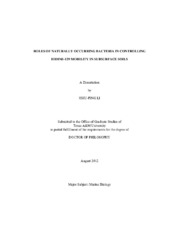| dc.description.abstract | 129I is of major concern because of its biophilic nature, excessive inventory, long half-life (~16 million yrs), and high mobility in the natural environment that depends on its chemical speciation. Iodide (I-) has the highest mobility than iodate (IO3-) and is the predominant species in the terrestrial environment due to prevailing pH and Eh conditions. In order to transform I- to less mobile organo-iodine (OI), strong oxidants are necessary to activate the first electron transfer step from I- to reactive intermediates. The aim of this study was to determine the influence of naturally occurring aerobic bacteria isolated from an 129I contaminated aquifer (F-area of the Savannah River Site, SC) on I- oxidation and OI formation.
It was demonstrated that 3 of 136 strains accumulated I- (0.2~2%) in the presence of H2O2, when incubated in the presence of an environmentally relevant concentration of I- (0.1 microM). The accumulation was likely through electrophilic substitution resulting in the iodination of cellular constituents. The results indicated that culturable I--accumulating bacteria are not directly responsible for the high fraction of oxidized iodine species (IO3- and OI, >50% of total I) present in the SRS F-area.
Several bacterial strains were found to be capable of stimulating I- oxidation through excretion of oxidants and enzymes. Organic acids in spent liquid medium from 27 of 84 aerobic bacterial cultures enhanced H2O2-dependent I- oxidation 2-10 fold. Organic acids enhanced I- oxidation by (1) lowering the pH of the spent medium and (2) reacting with H2O2 to form peroxy carboxylic acids, which are strong oxidizing agents.
In the absence of H2O2, spent medium from 44 of 84 bacteria cultures showed I- oxidizing capacities. One I- oxidizing bacterium was studied to characterize its extracellular I- oxidizing component(s). The I- oxidizing capability from the spent medium was inactive by treatments with heat and H2O2 and absent under anaerobic conditions. Conversely, NADH, NADPH and FMN additions stimulated I- oxidation in the spend medium. These results indicate an oxidase(s) catalyzed I- oxidation. Understanding the bacterial activities involved with I- oxidation and OI formation is expected to help reduce 129I mobility in water-soil systems. | en |


